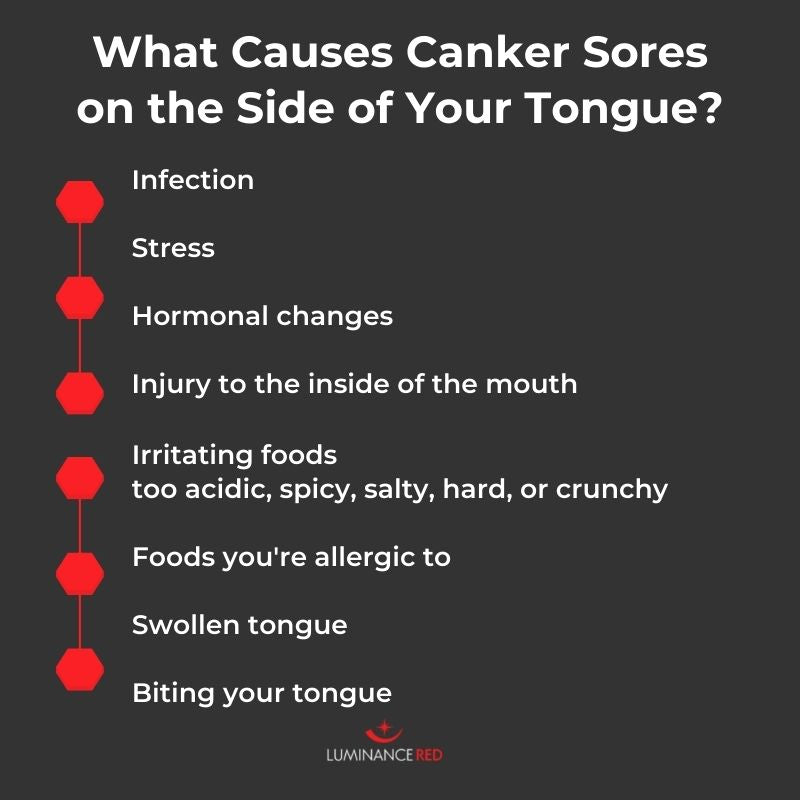Canker Sore on the Side of Your Tongue? Here’s What To Do

Canker sores usually develop on the inside of the lips or cheeks, but occasionally they develop on the side of the tongue as well.
How do you know if you have a canker sore on the side of your tongue? Is there anything you can do to treat it? And how can you keep this from happening again?
What Is a Canker Sore?
Canker sores are also referred to as aphthous ulcers. They are shallow lesions that develop instead the lips and mouth, and occasionally on the tongue. These yellow, gray, or white ulcers usually measure between 1–4 millimeters (mm) wide and have a bright red or pink border.
Canker sores are extremely common, and even though they can be very painful, they're not dangerous. They also can't spread from person to person through kissing or sharing drinks.
Many people experience a burning or stinging sensation in the affected area immediately before a canker sore emerges. The ulcers usually hurt the most in the first few days after they erupt and heal within 1–2 weeks.
Canker Sores on the Side of the Tongue
Canker sores on the side of the tongue are less common than canker sores on the inside of the cheeks and lips, but they do occur.
Is It a Canker Sore or Something Else?
If you have a sore on the side of your tongue, it's important to be sure that you're dealing with a canker sore and not a different condition. Then you can take the correct steps for your ulcer and your oral health.
There are several other conditions that can cause sores to appear on the side of the tongue. These include oral thrush, leukoplakia, oral lichen planus, and even cold sores.
Oral Thrush
Oral thrush is an overgrowth of Candida fungus on the mucous membranes that line the mouth. Oral thrush isn't dangerous, but it does cause some distinct, unpleasant symptoms:
- Milky, white lesions on the gums, inner cheeks, and tongue.
- Raised lesions that resemble cottage cheese.
- Cottony feeling in the mouth.
- Loss of taste.
Oral thrush is most common in infants and the elderly, and in people with weakened immune systems or diabetes. Inhaled steroids and mechanical ventilation can also lead to thrush.
Leukoplakia
Leukoplakia causes white patches and sometimes open sores in the mouth. Most patches occur on the inside of the cheeks, on the gums, underneath the tongue, or on the tongue itself. Unlike canker sores on the side of the tongue, leukoplakia on the tongue isn't usually painful.
It's important to identify leukoplakia because it's much more serious than a canker sore. Leukoplakia can be a precursor to oral cancer. Speak with your dentist if you think you might have leukoplakia.
Oral Lichen Planus
Oral lichen planus is a chronic inflammatory condition that causes white, lacy patches to develop in the mouth. Painful, red, open, swollen sores may also occur.
Signs of oral lichen planus appear throughout the entire mouth. Your healthcare provider can diagnose this condition, so speak to your doctor if you think you may have oral lichen planus.
Cold Sore on the Tongue
Cold sores are caused by the herpes simplex virus, type 1 (HSV-1). HSV-1 is highly contagious and spreads easily to trigger the formation of cold sores around the lips and mouth. Rarely, cold sores can also develop on the tongue.
If you develop a cold sore on your tongue, it's a good idea to avoid ingesting irritating foods and beverages and opt for immune-supporting foods that can help with healing. If the sore lingers beyond a few weeks, you may also want to consult your doctor.
What Causes a Canker Sore on the Side of Your Tongue?
Canker sores, including those on the side of the tongue, can have many causes. These can include:
- Infection.
- Stress.
- Hormonal changes.
- Injury to the inside of the mouth.
- Irritating foods, such as foods that are too acidic, spicy, salty, hard, or crunchy, as well as foods that you're allergic to.
- Ill-fitting dentures.
Specifically, a canker sore on the side of the tongue could be due to biting the tongue, either while eating or grinding your teeth in your sleep. If you grind your teeth while sleeping, your dentist may recommend the use of a night guard. This will prevent you from grinding your teeth and keep you from biting your tongue.
A swollen tongue can exacerbate the problem, making you more likely to bite it. Allergic reactions, yeast infections, dry mouth, and injuries can all cause the tongue to swell.

Is This More Than a Normal Canker Sore?
Two main factors could be involved if your canker sore doesn't resolve itself within 1–2 weeks: chronic canker sores and complex canker sores.
Chronic or Recurring Canker Sores
A chronic disease is one that lasts more than 12 months and requires ongoing medical attention or limits your daily activities. Canker sores are considered chronic if they occur repeatedly and affect your daily life.
Chronic canker sores can be caused by acidic foods, vigorous brushing, excessive flossing, dental appliances, allergic reactions, and ongoing stress, but they can also be linked to an underlying health condition.
Complex Canker Sores
The most obvious difference between a run-of-the-mill canker sore and a complex canker sore is its size. Complex canker sores can grow to 5 mm or more in diameter. They also take longer to heal, sometimes lasting as long as six weeks.
Complex canker sores may be accompanied by other symptoms like fever, swollen lymph nodes, and lethargy. These signs indicate that your canker sores may be related to a more serious underlying health problem.
How To Treat a Canker Sore on the Side of Your Tongue
Fortunately, over-the-counter canker sore medications abound in drugstores. Topical creams, ointments, liquids, and patches are available to treat canker sores and help them heal quickly. A number of home remedies may also provide relief.
Light therapy is another nonprescription option to treat canker sores. The Luminance RED Mouth Sore Treatment Device is an FDA-registered light therapy device designed to help you manage canker sores. Light therapy is one of the only chemical-free treatment options for canker sores with clinically proven effectiveness.
How To Prevent Canker Sores on the Side of Your Tongue
Preventing future canker sores is mostly about avoiding triggers. If you're prone to canker sores, try to avoid injuring your tongue by using a soft-bristled toothbrush, chewing very carefully, and steering clear of oral care products containing sodium lauryl sulfate. Also avoid foods with excessive spice, salt, and acid, and foods you're allergic to.
Taking care of your overall health can also help ward off canker sores. Aim for seven to nine hours of sleep each night and practice stress management techniques like exercise, meditation, and deep breathing.
Signs That You Should Call Your Doctor
Most of the time, a canker sore on the side of your tongue will resolve itself within a week or two. But you should call your doctor if you experience any of the following:
- Canker sores on the side of the tongue that keep coming back in the same spot.
- Canker sores accompanied by other symptoms, like fever or rash.
- Severe pain or difficulty swallowing.
- Canker sores that don't heal within 1–2 weeks.
- An unexplained growth in the mouth.

















